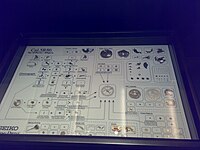|
Spring Drive Spring Drive is a name given to a series of watch movements produced by Epson in Shiojiri. The concept of using a mainspring to power a quartz timing package was first conceived in 1977 by Yoshikazu Akahane (赤羽 好和) at Suwa Seikosha[1] (now a part of Epson after a 1985 merger).[2] Specified to one second accuracy per day,[3] the movement uses a conventional gear train as in traditional mechanical watches, but rather than an escapement and balance wheel, instead features Seiko's Tri-synchro Regulator system in which power delivery to the watch hands is regulated based on a reference quartz signal.[3] Commercially released in 1999,[2] the movement is found in watches distributed by the Seiko Watch Corporation, including its Credor, Grand Seiko, Presage, and Prospex brands. MechanicsThe Spring Drive uses a conventional mainspring[3] and barrel[4] along with automatic and/or stem winding to store energy, just as in a mechanical watch.[3] However, the escapement and balance wheel in mechanical watches is replaced by Seiko's Tri-synchro Regulator system, a phase-locked loop wherein a rotor, which Seiko refers to as a "glide wheel", is powered by the mainspring barrel via a stator. The glide wheel in turn powers a reference quartz crystal and accompanying integrated circuit which controls an electromagnetic brake which then regulates the rotational speed of the glide wheel itself.[3] The glide wheel is intended to rotate eight times per second; the rotational speed is sampled once every rotation and a variable braking force is continuously applied to maintain that target frequency. As the glide wheel directly powers the seconds hand of the watch, this results in a true continuously sweeping second hand – in contrast to the beats per time motion resulting from the back-and-forth movement of traditional mechanical watches or the tick of typical quartz watches.[3] The movement is specified to ±15 seconds per month.[5] HistoryThe design was first conceived by Yoshikazu Akahane at Suwa Seikosha in 1977[1] and patents were applied for it in 1982;[5] in total, no fewer than 230 patents have been applied worldwide for this movement.[6] Initial development was hindered by the high energy consumption of the reference quartz crystal and integrated circuit[5] making a watch with a then-target 48-hour power reserve impossible;[7] another attempt in 1993 was also unsuccessful for the same reason.[5] It was not until a third attempt in 1997, using a quartz crystal and integrated circuit with energy consumption approximately one one-hundredth that used in the initial attempt in 1982,[7] that a Spring Drive watch with sufficient power reserve was deemed feasible.[5] Over 600 prototypes were produced during development.[1][3][8] The Spring Drive movement was announced publicly in 1997 and presented at the 1998 Basel Watch Fair.[1][8] In 1999, the first production models were made available in Japan as limited edition, manual-wind watches in both the Credor and Seiko brands.[2][5][8] The first non-limited model was released in Japan in 2002.[5] The 1st spring drive automatic-wind movement of Grand Seiko was released in September 2004, the reference number is SBGA001.[citation needed] The first automatic-wind Spring Drive model was released in 2005,[8] and coincided with the introduction of the Spring Drive movement to markets outside of Japan.[8] Calibers Early models, manual wind and 48h power reserve:
Current calibers with standard features. Time accuracy: monthly rate within ±15 sec (equivalent to a daily rate of ±1 sec) and power reserve (72h) indicator.
Current calibers with higher power reserve and higher accuracy. Time accuracy: monthly rate within ±10 sec (equivalent to a daily rate of ±0.5 sec) and power reserve (5 days) indicator.
Notes and references
|